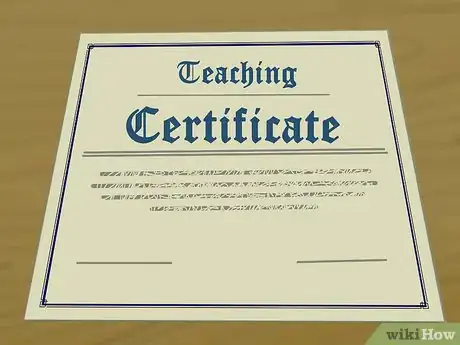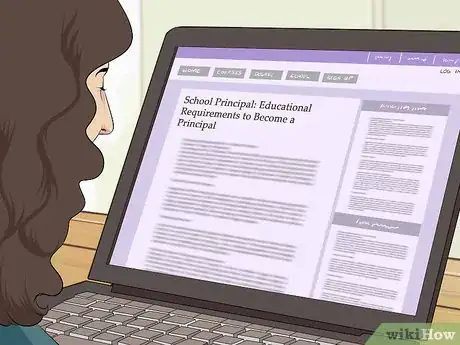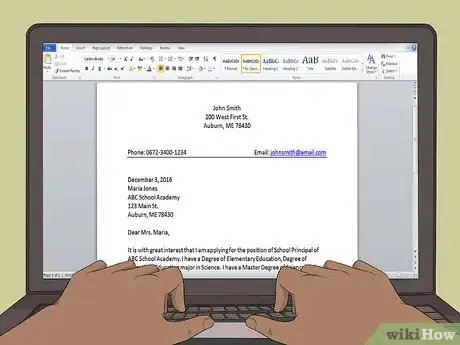This article was co-authored by wikiHow Staff. Our trained team of editors and researchers validate articles for accuracy and comprehensiveness. wikiHow's Content Management Team carefully monitors the work from our editorial staff to ensure that each article is backed by trusted research and meets our high quality standards.
There are 8 references cited in this article, which can be found at the bottom of the page.
This article has been viewed 31,554 times.
Learn more...
Becoming a school principal can lead to a long and satisfying career, whether you have a love for teaching, find pleasure in administrative work, or want to impact the lives of others through education. There are many different steps and processes involved with becoming a principal, which often come with many options and pathways. Learning as much about what requirements you’ll need before you begin the process will help you make the most informed decisions possible while you’re on your way to becoming a school principal.
Steps
Earning Your Bachelor’s Degree and Teaching Certificate
-
1Check your state’s degree and qualification requirements. Each state has varying requirements for school principals, from Masters in Science and Education degrees to school administrator certifications. Check with your state’s board of education to find out the exact qualifications and degree you’ll need to become a principal.[1]
- Reading books written by other educators will also help you understand the degrees, qualifications, and skills necessary to become a principal.[2]
-
2Earn a bachelor’s degree. Earning a bachelor’s degree is a general requirement no matter which state you wish to become a principal in. However, it is not always necessary to hold a bachelor’s degree in education in order to gain teaching experience and receive a teaching certification.
- There are many ways to earn a bachelor’s degree, from online to on campus. Find out which method you prefer and study hard!
- Although not always necessary, majoring in education will inform you of the many requirements, certifications, degrees, and pathways you will be able to pursue after graduation in order to become a principal.
Advertisement -
3Receive your teaching certificate or credentials. Receiving your teaching certificate, once you’ve earned a bachelor’s degree, is a requirement that will allow you teach at any level. Each state’s board of education has different requirements and specializations that are often fulfilled with a teaching certification, like choosing a specific subject or grade level. Consulting state specific teaching certification guides will help you determine which certification licenses and requirements you’ll need and in which state you’ll need them.[3] [4]
- Most teaching certifications require you to take a praxis test with the option of subject-specific testing.[5]
- It is not always necessary to specify the exact subject or grade you would like to teach. However, the more specific you can be the easier it will be to narrow down the relevant qualification and certification requirements.
- Receiving a National Board Certification is an advanced certification that supplements your state teaching certificate or credentials.[6]
-
4Gain teaching experience before applying to graduate school. Teaching before a master’s program is a great way to gain hands-on experience and be exposed to the general practices, issues, and concerns of other teachers and students. Apply for teaching positions by contacting your state’s board of education or inquire about open positions with schools directly.
- Teaching in your specialized subject or age group will introduce you to some of the necessary skills of becoming a principal, like communication, leadership, and motivation.[7]
- Teaching will also allow you to gain interpersonal experience by interacting with other teachers and administrators on a daily basis.
Gaining Experience and Earning a Master’s Degree
-
1Earn a master’s degree. Almost all principal positions, whether at a public school or private school, elementary or high school, require a master’s degree in education leadership or education administration. A master’s degree in education generally expands on teaching curricula while also focusing on school law and finance, educational theory, and psychology.[8]
- Many master’s degrees in education require around 1-5 years of teaching experience. The number of years depends on a number of factors, such as the graduate program’s requirements and the school district you’d like to work in.[9]
- A master’s degree will also introduce you to the various administrative responsibilities of being a principal, such as dealing with superintendents and school boards, organizing and hiring staff, and occasional student discipline.
-
2Teach as many ages, areas, and subjects as possible. The more teaching you are able to experience the more context and information you will have with regards to administration. Although it can be important, and sometimes necessary, to specify your areas, ages, or subjects of interest, the broader the experience you can get teaching the more experience you will have communicating with varying age groups, parents, and administrators.[10]
-
3Demonstrate your leadership skills. It’s not always possible to gain experience in an administration role without completing a handful of requirements. However, there are many ways to exercise and demonstrate your communication, interpersonal, leadership, and critical-thinking skills by getting involved with your school and community.
- Volunteer for committees, activities, or planning groups at your school to extend your administrative skills.[11]
- Help organize fundraisers, blood drives, and school dances.
Applying for Principal Positions
-
1Choose an age group or specific type of educational institution. Although the required certifications for principals can look similar in different pathways, the roles of active principals often require many different skill sets. From elementary to high school, public to private, deciding on which type of institution you would like to apply to will narrow down the necessary information you will need for letters of recommendation, cover letters, and interviews.
- Consult a past professor or administrative supervisor if you have a particularly diverse background, teaching many different ages and subjects, to see what you might be best suited for.
- Consider your long-term goals and what initial administrative jobs may help you realize those goals.
-
2Research your district’s principal qualifications. Each district, like each state, has varying requirements for their potential principals. Consulting the state’s board of education as well as the district’s board of education will help you determine the particular requirements of the open position.[12]
- Many districts have job boards posted online where you can view posted vacancies, application requirements, and recommendations for applicants.
- Many districts also require principals to pass an exam or complete training. Consult the school board in the district in which you are applying if you are unsure what your district requires.[13]
-
3Look for advancement opportunities. Many administrative positions come with the possibility of advancement. Applying for an assistant or vice principal position may often lead to a head principal position, and potentially even a position as superintendent.[14]
- Consult your district’s school board as well as the particular school you are applying to in order to determine what opportunities there are for advancement.
-
4Secure letters of recommendation. Letters of recommendation, like with most other job applications, go a long way to help securing you a place as a school administrator. Contacting previous administrators or principals from schools in which you taught, as well as other professors from schools in which you were a student, will help you prove your potential and experience.
- Consulting past administrators or professors may also provide you with useful information about applications, districts, or states to consider.
- Be sure to leave at least a few weeks for others to write your letters of recommendation before submitting them.
-
5Write a specific cover letter. It’s time to write a cover letter once you have determined which school and for which administrative role you are applying. Be sure to address either the hiring school board or hiring administrator directly while clearly expressing your past experiences and future goals which make you a qualified candidate.
- Try to incorporate specific hands-on experiences, like teaching a particular age group, organizing school-wide events, or specific graduate coursework.
-
6Prepare for an interview. The interview may be the last process before you are hired on as a school administrator or principal. Be sure to review your application materials, as well as the specifics required for the role you have applied to, before the interview.
- Research the concerns and statistics of the school district you are applying to and state the ways that you might help find a solution.
References
- ↑ http://www.educationdegree.com/articles/become-a-principal
- ↑ http://hepg.org/hep-home/books/becoming-a-school-principal
- ↑ https://www.teach.org/teaching-certification
- ↑ http://www.teaching-certification.com/teaching-certification-requirements.html
- ↑ https://www.teach.org/teaching-certification
- ↑ https://www.teach.org/teaching-certification
- ↑ http://www.uscranton.com/resources/careers/steps-to-becoming-a-principal/#.V_WM9qIrLqY
- ↑ http://www.schools.com/visuals/how-to-become-a-school-principal.html
- ↑ http://www.bls.gov/ooh/management/elementary-middle-and-high-school-principals.htm#tab-4
- ↑ http://www.uscranton.com/resources/careers/steps-to-becoming-a-principal/#.V_WM9qIrLqY
- ↑ http://www.uscranton.com/resources/careers/steps-to-becoming-a-principal/#.V_WM9qIrLqY
- ↑ http://www.bls.gov/ooh/management/elementary-middle-and-high-school-principals.htm#tab-6
- ↑ http://www.schools.com/visuals/how-to-become-a-school-principal.html
- ↑ http://www.bls.gov/ooh/management/elementary-middle-and-high-school-principals.htm#tab-4









































































